One confession for you — I am an adult doll collector. Another one — these days I just cannot stop listening to The Pussycat Dolls. Whether in the form of Korean ball-jointed collectibles or 00s manufactured pop stars, the concept of the doll as a token of hyper-femininity fascinates me. As I was playing the 2008 album Doll Domination on loop on the treadmill, I grew obsessed with the Pussycat Dolls’ band name and their overall imagery, and started rummaging through my brain drawers looking for other artists using the figure of the doll in their work but subverting it in a grossly anti-pop manner. That’s when inspiration struck.
As a disclaimer, I have to state that this essay does not touch on the reclaiming of the word ‘doll’ by the queer and specifically trans communities, as it is a mere side quest of mine focused on the abrasive topic of dolls as objects sculpted by men. There are definitely some ties and parallels to be made there, however I am not sure that I could write anything about the topic that has not been said before by my queer siblings, and been said better. After reading this lighthearted piece, I highly suggest delving into the history of trans femme dolls, and how the term was coined by the Black trans women of the ballroom scene in the sixties. Impact has a great little history lesson about this on their Instagram page, right here.
Born in 1902 Germany, Surrealist photographer, sculptor and illustrator Hans Bellmer has been one of my favorite artists for almost a decade. I first stumbled onto his life-sized female dolls in the throes of my Lolita addiction, and consequently became captivated by his unsettling sculpture and photography, in which dismembered realistic puppets pose as unattainable beauties. His images are both disgusting and enchanting, like some kind of squeaky-clean gore dream. Bellmer’s Artsy auction website profile provides the following description of his work.
Hans Bellmer is best known for his sculptures of grotesque, life-size dolls which resemble mangled, pubescent girls. Each of his dolls possesses a skeleton of wood and metal, which the artist padded out with papier-mâché and plaster curves; often, they are headless, twisted into sexual poses, or deformed by missing or superfluous limbs.
Although I would have gladly found a way to meet him and take him to his first dance-pop concert, Bellmer died in 1975, and thus never got the chance to get familiar with the Pussycat Dolls’ ground-breaking body of work.
The Pussycat Dolls were initially born in 1995 in California and marketed as a ‘Neo-burlesque troupe’, before they went on to sign a record deal in 2003 which was the catalyst for the creation of the actual pop girl group, consisting of Nicole Scherzinger, Carmit Bachar, Ashley Roberts, Jessica Sutta, Melody Thornton, and Kimberly Wyatt. Their debut album, simply titled PCD, came out in 2005 and went multi-platinum around the globe — while the aforementioned Doll Domination was released in 2008. I am most familiar with the latter as it was hitting the charts around the time I gained cultural consciousness, but their legacy in the music industry still stands strong today.
So there I was at 8 in the morning at my Brooklyn gym, shuffling my Pussycat_favorites playlist, when I found myself staring at the PCD album cover for longer than usual, and busting out laughing. Guys. Nicole’s waist. Something about this cover really is so messed up but also so deliciously camp, and it makes it impossible to stare away. Nicole Scherzinger is not only in the center of the picture but also seemingly emerging from a glowing green halo, her waist edited into oblivion to look smaller than her neck. There is simply no reason for all six of the Dolls to be showing off their side profile rather than posing up front on the cover of their debut album, if not for some unashamed body checking, sucking their stomachs in and sticking out their asses while maintaining a painful-looking over-the-shoulder gaze. I was mesmerized. Where the orthorexia-stricken 2000s saw the ultimate fitspo, I saw the silhouette of a Bellmer doll.
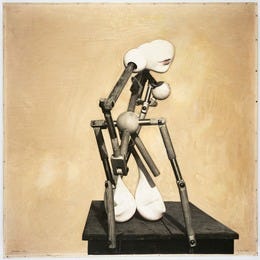

Bellmer began creating disturbing dolls in 1933, the year Adolf Hitler assumed power in Germany. Many have interpreted them as acts of political defiance against the Aryan ideals and social norms promoted by the Nazis, whom he openly opposed, and expressions of the personal outrage he felt towards his father, who had joined the Nazi party. Bellmer himself stated, "If the origin of my work is scandalous, it is because for me, the world is a scandal." (source)
Bellmer’s 1937 The Machine-Gunneress in a State of Grace is a sculpture made of wood and metal, and currently calls the New York City MoMA home. The sculpture sprung from Bellmer’s mind and hands about a year before he left Berlin, and stands as a striking testimony of the violence in place in Germany under the Nazi dictatorship, and a protest against the physical ideals and subsequent torture inflicted by the fascist government. The Machine-Gunneress is perversely fragmented and reassembled into a half-female, half-weapon chimera, whose ball-jointed articulations offer endless options for sadistic distortion and recombination.
Don’t cha wish your girlfriend was raw like me?
Don’t cha wish your girlfriend was fun like me?
In the sexed-up realm of the 2005 music industry, the Dolls are twisted and rearranged into aspirational but unachievable athletic figures, and their bodies like weapons shoot straight to the top of the Billboard charts. Words like raw and fun become synonymous, effectively creating the concept of a golem of meat as the most erotic companion — the ideal woman.
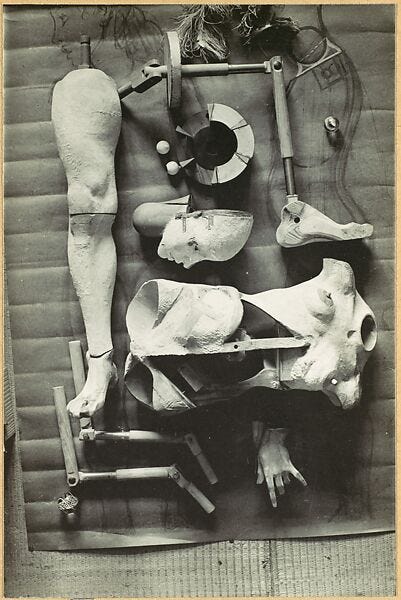

The figure of the doll (American counterpart to the French poupée) is recurring, even obsessive, in Hans Bellmer’s work. Dozens of his pieces bear the same title: La Poupée, or alternatively Les Jeux de la Poupée, all numbered as extensions of the same artwork. In the Poupée above, the doll lies supine but unborn still, consisting in an arrangement of splayed limbs on a sheet of construction paper. The creature is waiting to be made, waiting to be sculpted by her master. On the 2008 Doll Domination album cover, the Pussycats lay flat against a crisp white backdrop like paper dolls, this time twisted at a mind-boggling angle enabling them to not only display their toned-side-profile-waist-and-chiseled-jawline, but also show cleavage. Long live Doll world! Their 90 degree torso pivot looks so effortless you would think they too, were ball-jointed. (The French word capillotracté, or tiré par les cheveux, would be perfect in this situation, but alas I am once again burdened by the limits of language). One woman in each corner of the frame and Nicole in the center because, well, obviously — almost making you think of Yugi-Oh’s Exodia (hey gamers ❤️), a forbidden creature split five-way which, when assembled and summoned, ensures the player an automatic win.
The perfect woman takes shape in Bellmer’s arrangements of carefully selected body parts and through the display of the Pussycat Dolls ensemble cast, coming in five slight variations of conventionally attractive femininity (hair color may vary, but not breast size) — making it possible for the audience to single out their favorite traits in all five women and mentally combine them into peak wet dream material.
So they appear, both Poupée and Dolls objects of cult, sculpted by men and lying there waiting to be picked up, before they are inevitably picked apart again.
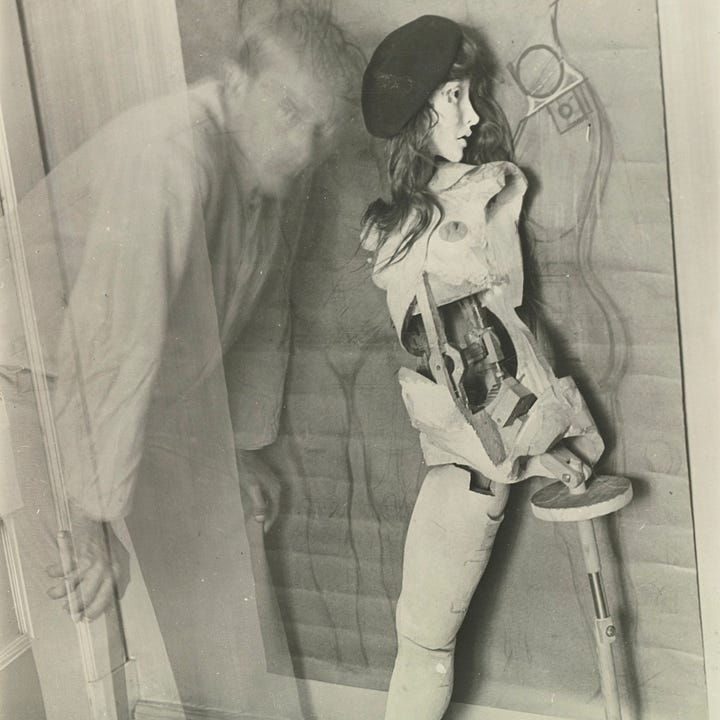

On rare occasions, the Doll poses for the camera alongside a Man, though he is not initially perceived as the main character in the image — or at least it seems to the untrained gaze. All eyes on the doll in the center of the frame, just like a circus.
In the photograph above titled Self portrait with die Puppe, long-exposure makes Hans Bellmer appear as a translucent figure, casting a shadow over his own piece of art and reminding us of his omnipresence. Die Puppe is propped up against the wall, one-legged, ultimately nothing without her creator. I don’t want to overanalyze the work of a deceased artist who, himself, did not give much explanation for his art, but I cannot ignore the fact that Bellmer was only ever creating and dismantling female-looking bodies. Even more so, given the fact that his dolls are overtly sexualized and almost always resemble young girls or women, à la Balthus. Here, his Doll is a beret-wearing, crippled and eviscerated Venus de Milo with her nipples erect, looking coyly to the side and offering her cheek as if to avoid being kissed on the lips by her maker. Bellmer’s ghost stares back at the viewer with an air of defiance, half-bent with his hands firmly placed on his knees — a strong contrast with the broken-up body of the doll, unable to maintain itself up.
You're the very reason why I keep a pack of the Magnum
And with the wagon, hit you in the back of the Magnum
For the record, I don't think it was something you did
Shorty all on me 'cause it's hard to resist the kid
Busta Rhymes’ verses on The Pussycat Dolls’ Don’t Cha are pretty appalling. Upon rerecording the song with the band in hopes that a strong feature would help launch their career, he adds a handful of unabashedly sexualized lyrics to a track which already stood as a man-teasing anthem. The reference to intercourse with his lover as “hit you in the back” evokes violence and — to me at least — the use of a Magnum gun cartridge rather than the intended Magnum condoms or Dodge vehicle. The violent undertones go on throughout his verse, claiming the woman he’s been with had no say in the fact that they had a sexual relation and that it was “all on [him]”. Rhymes leaves us here, both wondering if he is actually referring to assault or at least non-consensual intercourse ; and faced once again with infantilization of his lover and pedophiliac undertones by claiming that “it’s hard to resist the kid”. We circle back to Bellmer’s weirdly young-looking perverse sculptures, who convey the idea of femininity just enough so that they appear human-like and somehow disturbingly desirable in pictures, but not enough to benefit from empathy.
In her 2010 book Girl Power, Marisa Meltzer discusses the dishonesty in the PCD’s marketing strategy which relies on praising their take on pop music for being empowering and sex-positive.
Girls besotted with the idea of becoming the group's seventh member gushed about how the Pussycat Dolls stand for female empowerment, but their hummable hit "Don't Cha" couldn't be further from feminism. The song's lyrics—"Don't cha wish your girlfriend was hot like me/Don't cha wish your girlfriend was a freak like me"—put forward the belief that a woman's worth lies solely in her appearance and sexual permissiveness and just furthers the notion that women are in competition with one another over men.
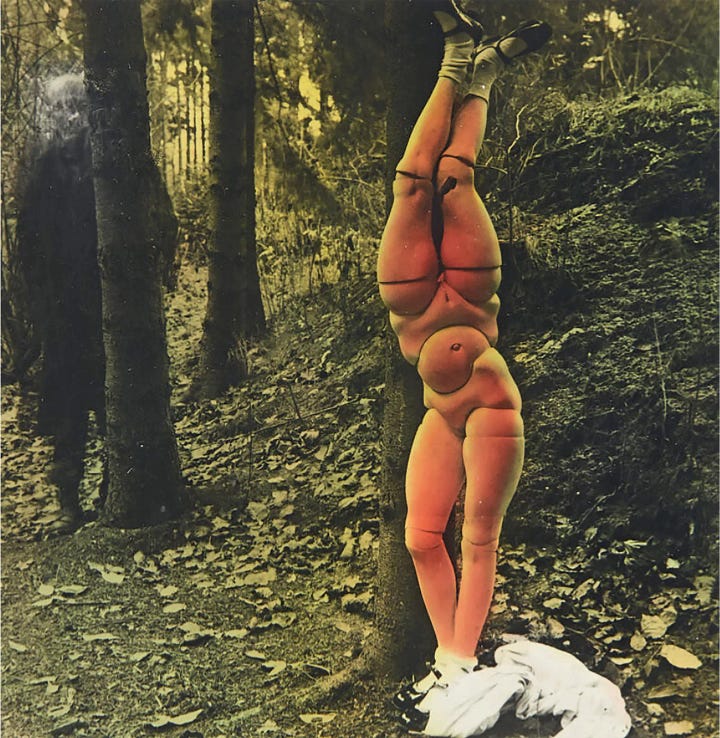
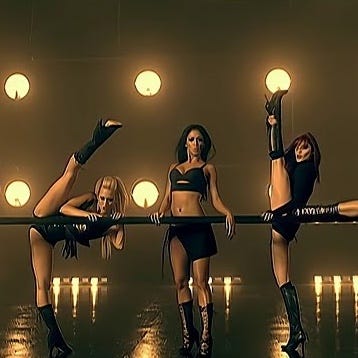
I’m telling you to loosen up my buttons, babe […]
Take the chance to recognize that this could be yours
Buttons, joints and screws — they all get loosened and rearranged for men’s viewing pleasure (if not more). In the Buttons music video, the Dolls demonstrate jaw dropping flexibility in order to attract their love interest and show him all the different positions he’d be able to bend them into, pussy(cat) facing the world. In Les Jeux de la Poupée VII, Hans Bellmer sets his scene in a forest. In the foreground stands his reverse topsy-turvy Poupée — all legs and double-crotched rather than two-faced. The photograph is painted over to give her skin a sunkissed orangey tone, letting the eye focus even more on her two sets of schoolgirl white socks and black patent Mary Janes combo. At this point we really cannot deny Bellmer’s blatant intent to make his dolls look prepubescent. His Wikipedia biography enigmatically gives us a little bit of Humbertian context for Bellmer’s obsession, stating that “events of his personal life also including meeting a beautiful teenage cousin in 1932”, or the year he turned thirty. Bellmer was Vladimir Nabokov’s almost exact contemporary, his life spanning the years 1902-1975, versus 1899-1977 for the Russian author. Did he ever see some of himself in Nabokov’s antiheroes? Was the unfortunate Bellmer cousin a real-life Annabel Leigh, which he spent his entire life and body of work recreating and twisting to fit his illicit fetish?
The Pussycat Dolls and the stranded Poupée adopt the same pose, legs up and spread apart, ready to welcome any visitor — as if to say, don’t even bother looking me in the eyes. But I wonder, whose message is it really, if not some male executives’ and/or puppetmasters’? Bellmer’s distraught schoolgirl reminds me of one of my favorite unreleased Lana Del Rey songs with very obvious academic references, Boarding School.
Let’s do drugs, make love with our teachers
[…]
You thought that I was just a calendar kitten
But now you heard me purring, tiger, you’re smitten
Another kitten bites the dust.


In his sketches and drawing work, Hans Bellmer forgoes the teenage girl imagery and steps into more explicitly adult themes. The information on his Stiletto series is very scarce, making it hard to analyze the intentions behind the drawings without potentially twisting Bellmer’s vision. The sketch features a plethora of female body parts drawn on canvas in black ink with pale pink accents — stiletto heels, nipples and vulvas. Let us recall French shoemaker Christian Louboutin’s comments on his own footwear designs.
What is sexual in a high heel is the arch of the foot, because it is exactly the position of a woman's foot when she orgasms.
This is a French middle-aged man speaking so of course this statement is tragically binary and only evokes the image of a very basic, heterosexual and cisgender kind of sexual interaction. But it also shows how much society revolves around the idea of sexuality. Shoes, art, music — everything is sex.
Is the color scheme in Hans Bellmer’s illustration meant to indicate what goes where? Can we imagine the mystery woman starring in this tableau vivant titillating her own genitalia with one of her pairs of high heels?
I don’t need a man to make me feel good […]
I can get off when you’re not around, oh!
On their single cover, the Pussycat Dolls stand proudly (facing us, for once!) clad in all-black against a pink background with I Don’t Need a Man emblazoned under their feet in a pop-rock gothic font. They are all wearing stiletto heels. The color palette and themes are the same in both the PCD artwork and Bellmer’s illustration — but while the latter can be seen as a study of traditionally unseen solo female sexuality, the former fails to convince us of the Dolls’ sexual independence, given that all the visuals still seem to cater so much to the male gaze.
The last of Hans Bellmer’s artworks I chose to focus on today is his illustration of the reedition of Monsignor Bouvier’s 1864 The Mysteries of the Confessional. Written by a Catholic priest, the book is a lambasting of lust, consisting in an enumeration of all the different sexual ways to sin against the teachings of the Church — with oddly specific and detailed descriptions coming from someone who is supposedly advocating against those very acts. Bellmer cheekily choses to illustrate each chapter of The Mysteries in his own perverse style, showing us what really goes on behind the curtain of the Confessional — and potentially in Bouvier’s frustrated mind.
And it's a little late for explanations
[…]
I don't want to stay another minute
I don't want you to say a single word
Hush, hush, hush, hush
Releasing a song titled Hush, Hush and subsequently going on to state all the things you don’t want to say sounds quite misleading, but preterition is commonplace in music and literature alike. So maybe it is “a little late for explanations” and dissertations on bygone Surrealist and dance-pop eras. As a mini-sized model of a human, most frequently female, figure, the doll is by definition nothing more than a medium to project fantasy onto. But — despite being largely accepted as a childish toy — its sexualization runs rampant in art and its related industries, and is repeatedly used to sell sex and for shock value. Hans Bellmer claimed his work to be a critique of the formatting of human bodies by fascist governments, but would his work have been as publicized had it featured grown men? It seems, whether in political art or the entertainment industry, a doll is a gun. As a child I was told to always be respectful of dolls and other inanimate toys, as they were said by folk legends to magically come alive at night when humans were long asleep, wanting to get revenge on those who had wronged or discarded them. I will keep an eye out for the ones in my bedroom.
Sources:
• https://en.wikipedia.org/wiki/Hans_Bellmer
• https://en.wikipedia.org/wiki/The_Pussycat_Dolls
• https://www.wikiart.org/en/hans-bellmer/the-machine-gunneress-in-a-state-of-grace-1937
• https://www.artsy.net/artist/hans-bellmer
• https://www.instagram.com/impact/
• https://www.sothebys.com/en/auctions/ecatalogue/2012/photographs-n08885/lot.137.html
• https://www.metmuseum.org/art/collection/search/265390
• https://www.dicebreaker.com/games/yu-gi-oh-tcg/feature/yu-gi-oh-exodia-win-condition
• Marisa Meltzer, Girl Power (2010)
• Vladimir Nabokov, Lolita (1955)
• https://www.theguardian.com/lifeandstyle/2011/oct/23/christian-louboutin-high-heels-orgasm




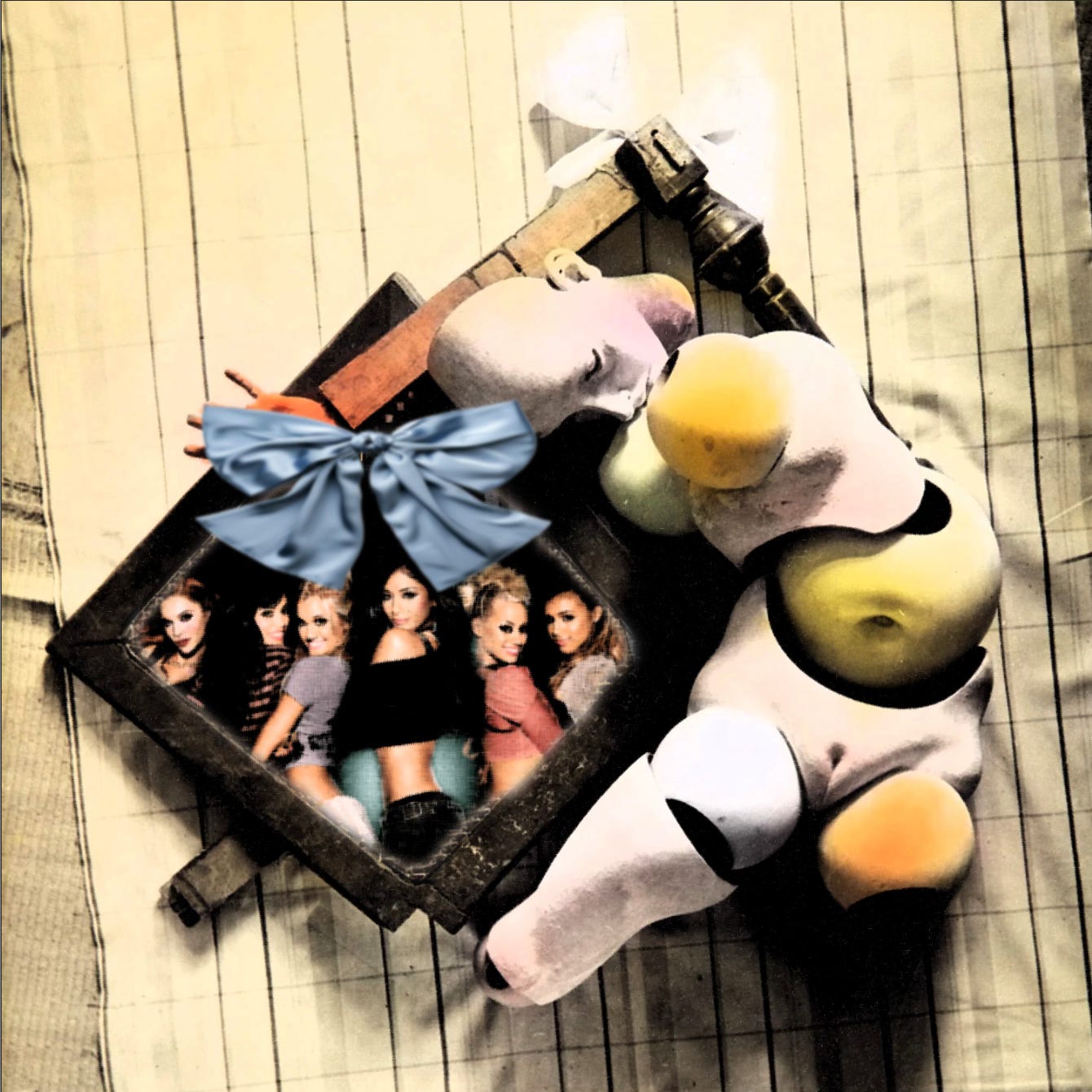

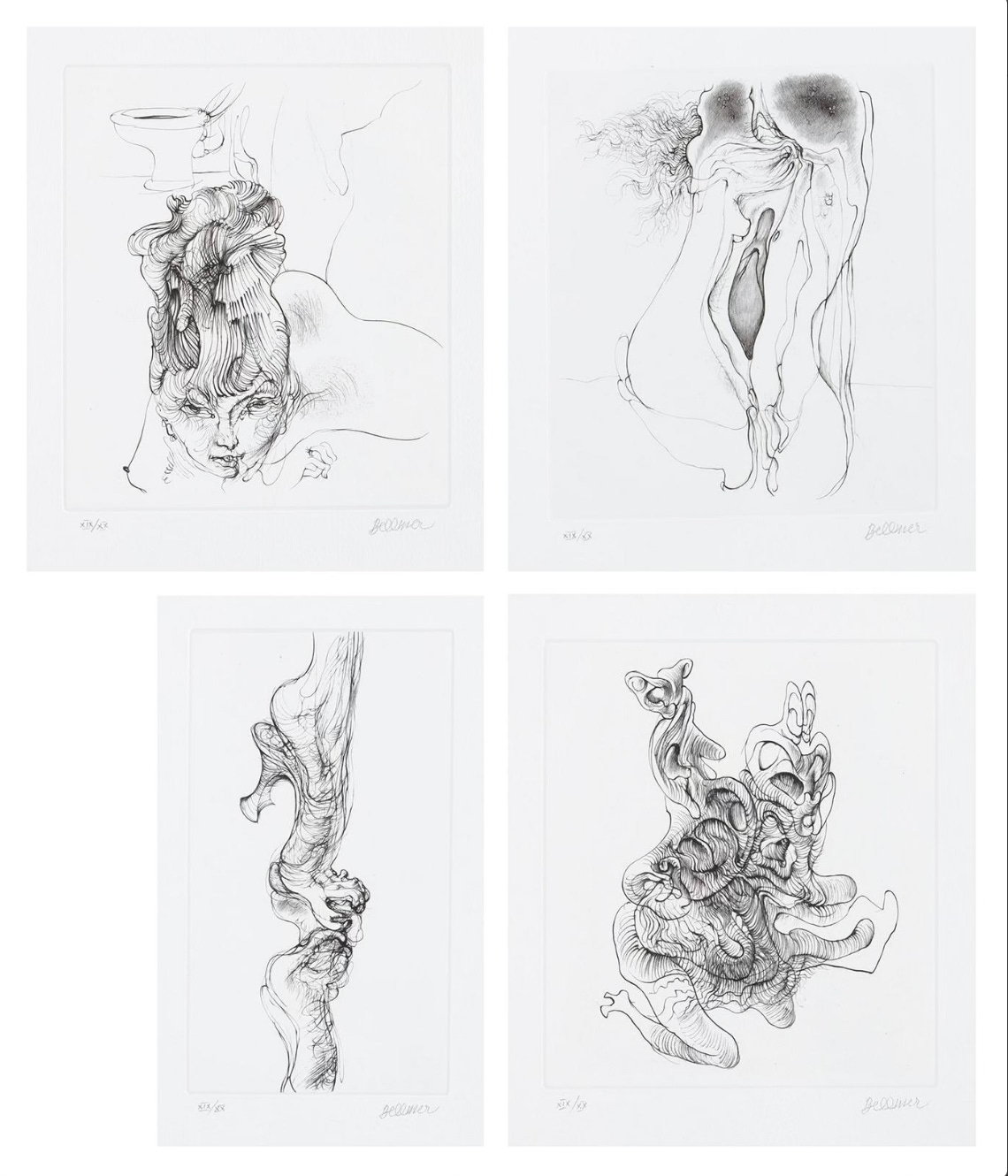
Do you know the Instagram feed @artbutmakeitsports ? I think these essays are Art But Make it Music. I love the form.
I’m so glad you included mention of the drawings! I saw a show of them at the Ubu Gallery in 1998 and they were just remarkable. (I think Unica Zürn started drawing before him perhaps?)